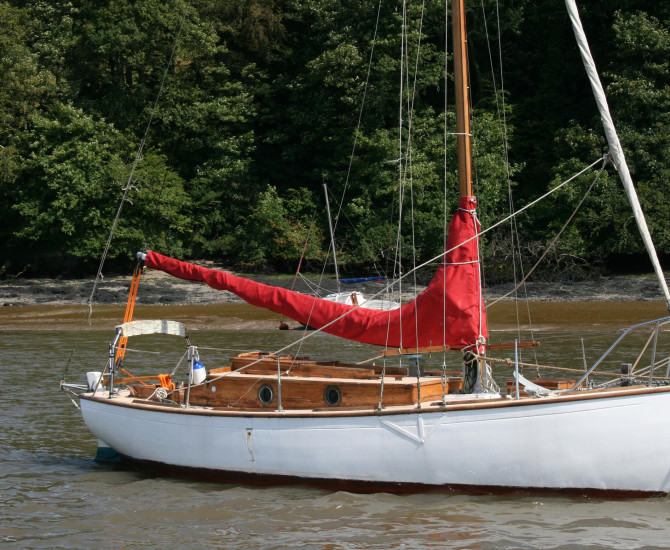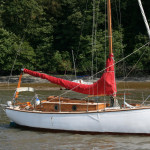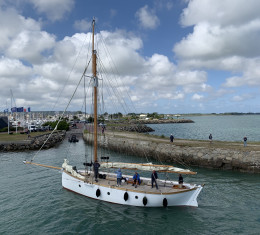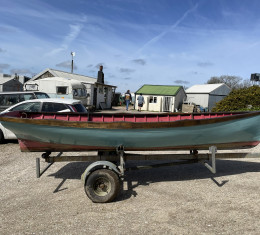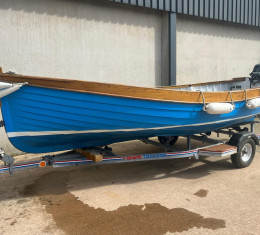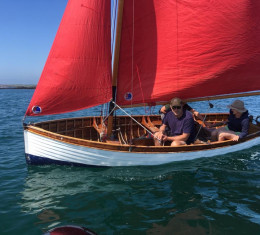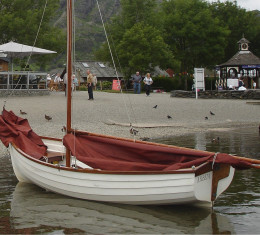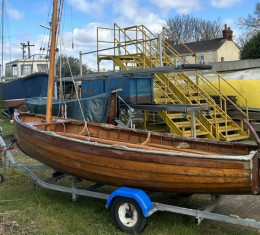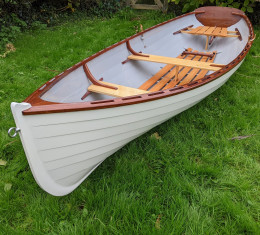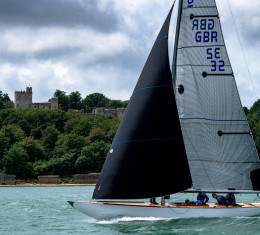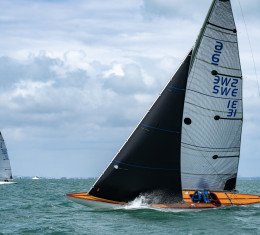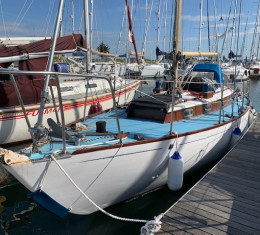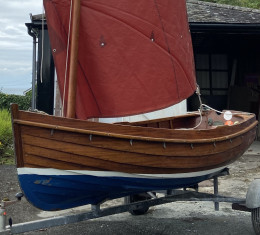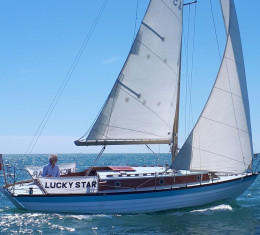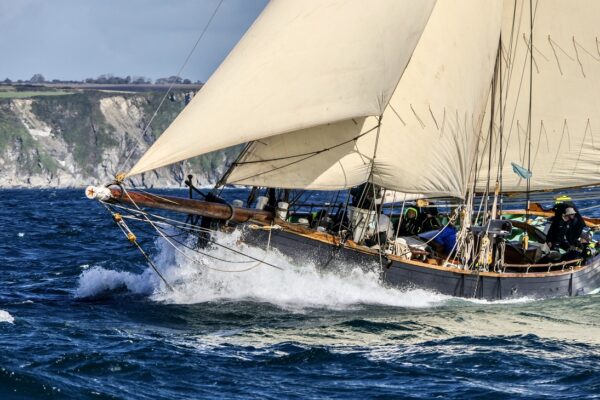Sailing yachts
Full specification
Wooden ships comments on this Harrison Butler z4 Tonner
One of some 52 Harrison Butler Z4 tonners built by Lockharts of Brentwood, Essex before the War, this one launched in May 1938.
Planked in 13/16ths pitch-pine all copper fastened to steam bent American elm timbers and 6” centres.
Close inspection revealed that most of the steamed timbers through the midships section and some aft are twin laminations indicating they have probably been replaced at some time in the past. Several are showing signs of cracking at the turn of the bilge so all through the midships section behind the settee berths they have been sistered in the 1998 refit (see page 3), a neat job.
A pair of angle iron frames in way of the mast are cleverly set off the planking to avoid future problems.
Oak back-bone with long iron ballast keel. Phosphor bronze bolts all replaced in 2005.
Several ferrous strap floors are fitted on pads laid on the inside face of the planking, not on the timbers as is usual. Reportedly new s/s bolts in the floor arms in the 1998 refit.
Deck
Original canvas covered pine deck as was traditional in those days, replaced with ply deck and sheathed with epoxy glass in 1998 refit. Teak toe rails.
Varnished teak fore hatch.
Regalvanised stemhead fitting with stbd side chain roller.
Varnished teak coach-roof with 2 bronze opening ports each side, teak grab rails.
Varnished teak sliding hatch and twin doors to the cabin entrance.
Varnished teak T&G cock-pit bulkhead. Engine control panel in the bulkhead to stbd of the entrance door. Little bronze framed opening window in the port side bulkhead to match.
Deep, very safe little cock-pit in teak with scrubbed seat locker lids each side, access to stowage and 6 gall stainless steel fuel tank under aft deck. Stowage under the side decks.
Manual bilge pump under the stbd side deck.
Scrubbed teak triangular sole board lifts to access the shaft and stern bilge.
Pin rail across the after cock-pit coaming with pegs to hold the tiller – a simple form of auto-pilot.
Rig
3/4 bermudian sloop rig on varnished pine mast with single spreaders and jumpers over, set in recently galvanised steel tabernacle just fwd of the coach-roof.
Galvanised rigging wire replaced around 2000, twin lowers and cap shrouds to distinctive external chain plate bracket, all regalvanised in the last few years.
Single standing masthead back-stay to galvanised bumpkin, twin chains down to the hull. The A-frame steel bumpkin forms part of the galvanised sheet horse over the tiller.
Running back-stays on bronze levers.
Rectangular section slab reef boom sheets to the horse on the aft deck over the tiller with modern tufnol blocks.
Pair of tufnol cock-pit sheet winches.
Sails
Mainsail 190sq’
Recent genoa 70sq’ by Scanes of Topsham on Hood 705 Seafurl roller gear.
Spinnaker with pole
Several older sails.
Machinery
Yanmar 1GM 10hp 1-cyl diesel engine installed new in 2000 with new shaft and bearing to new 2004 port off-set 2-blade folding prop, gives her 5knts.
This engine was overhauled for the present owner in spring 2014 by Devon yard which included head off, new piston rings, new head and sump gasket etc.
6 gall stainless steel fuel tank.
2 x 12v batteries under stbd settee berth with change-over switch.
Accommodation
2 berths. Generous settee berths each side with good sitting head-room open right up to the stem. Sea toilet under mahogany joinery fwd between seats.
Lots of stowage space forward.
2 pairs of steel compression post mast supports forward at the fore end of the coach-roof.
2-burner gas cooker on surface to stbd aft, locker to port aft. Stainless steel sink in the teak work surface with hand pump from new stainless steel water tank under the port settee berth.
Engine under step between with 2 doors and sliding hatch to the cock-pit.
Bosun compass.
Cobra VHF DSC radio.
Nasa sounder
Plough anchor with 50 meters 5/8” chain.
Beaching legs.
Warps and fenders.
Cock-pit cover and boom cover, both new 2006.
Major refit in 1998 including replacing coach-roof deck, sheathing it and the main deck, replacing the rudder, re-galvanising all ferrous deck fittings, re-wiring, and doubling cracked timbers each side around the turn of the bilge adding to the strength of this robust little yacht.
Further refit in 2005 when the keel bolts were replaced and again earlier this year in present ownership.
Enthusiastically cruised in past ownership from her Cornish mooring, crossing easily to France even in heavy weather. Some years ago she won her class in the |Round the Island Race when she was based in Lymington.
An honest little boat and a sound example of this very pretty design, still the ideal mini cruising yacht she was designed to be.
Zenocrate was built in Brentford, London, by A Lockhart Ltd and was launched in May 1938. The first owner was R G Collingwood, Professor of Philosophy at Oxford.
Collingwood and his 3 sisters had grown up in the Lake District, on the banks of Coniston. His father – an artist, historian and expert on the Icelandic sagas – was an associate of John Ruskin, who lived close by.
In 1896 Arthur Ransome became acquainted with the family. He learned to sail on their boat ‘Swallow’. It was this friendship with R G Collingwood and his three sisters, and in due course with the next generation also, that provided the basis for Ransome’s books about ‘Swallows and Amazons’. This series has provided several generations of readers with the inspiration to go sailing. Anyone who reads these books is reading – in effect – about the first owner of Zenocrate, as a child sailing on Coniston.
It was during the later part of his life that Collingwood owned Zenocrate. He suffered a stroke in February 1938 and he feared that this might be succeeded by others (as indeed proved the case). He hoped that the pleasure and relaxation he would gain by sailing Zenocrate would delay this.
There is also perhaps a clue here for the choice of the name Zenocrate. Zenocrate was the wife of Tamerlane, the 14th Century conqueror of Central Asia and India, immortalised in Christopher Marlowe’s play. She died young and in Marlow’s play there is a very moving lament over her short life. It seems possible that Collingwood, in choosing such a name, was all too conscious of the likely brevity of his own remaining years.
Note:
The present owner has copies of the relevant folios of the Registry of British Ships, showing the succession of owners from the start. There is also a pdf from the recent new edition of Collingwood’s Autobiography, which refers to the purchase and early voyages of Zenocrate
Disclaimer:
These particulars have been prepared in good faith from information provided by the Vendors and are intended as a guide, Wooden Ships cannot guarantee or warrant the accuracy of this information nor warrant the condition of the vessel. The Purchaser should instruct his agent or surveyor to validate all details as necessary and satisfy himself with the condition of the vessel and its equipment.
Wooden Ships classic yachts brokers have an extensive database of boats for sale. With a wide range of sailboats, classic yachts, motor yachts and small classic boats, Wooden Ships has one of the largest selections of traditional wooden boats and yachts for sale in the UK.
Disclaimer:
These particulars have been prepared in good faith from information provided by the Vendors and are intended as a guide, Wooden Ships cannot guarantee or warrant the accuracy of this information nor warrant the condition of the vessel. The Purchaser should instruct his agent or surveyor to validate all details as necessary and satisfy himself with the condition of the vessel and its equipment.

